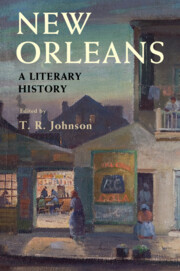Book contents
- New Orleans
- New Orleans
- Copyright page
- Dedication
- Contents
- Contributors
- Preface
- Acknowledgments
- Chapter 1 Swamp City
- Chapter 2 Mixed Motives
- Chapter 3 “As I Have Seen and Known It”
- Chapter 4 What New Orleans Meant to Walt Whitman
- Chapter 5 Coloring Sex, Love, and Desire in Creole New Orleans’s Long Nineteenth Century
- Chapter 6 The White Creole Tradition
- Chapter 7 The Civil War’s Literary Aftershocks
- Chapter 8 Illusion and Disillusion
- Chapter 9 Local Color, Social Problems, and the Living Dead in the Late-Nineteenth-Century Short Fiction of Alice Dunbar Nelson
- Chapter 10 Kate Chopin, Edna Pontellier, and the Predicament of the Intellectual Woman in New Orleans
- Chapter 11 Converging Americas
- Chapter 12 A Jazz Origin Myth
- Chapter 13 “Stepping Out” of the Storyville Frame
- Chapter 14 Louis Armstrong’s Autobiographical Art
- Chapter 15 New Orleans, Modernism, and The Double Dealer, 1921–1926
- Chapter 16 “Because What Else Could He Have Hoped to Find in New Orleans, If Not the Truth”
- Chapter 17 “The Place I Was Made For”
- Chapter 18 A Civil Rights–Era Novel of the American Civil War
- Chapter 19 How to Survive the Best Environments
- Chapter 20 Tom Dent and the Development of Black Literature in New Orleans
- Chapter 21 The Gothic Tradition in New Orleans
- Chapter 22 A Flaneur in the French Quarter and Beyond
- Chapter 23 Literary Fiction by New Orleans Women, 1961–2003
- Chapter 24 Asian American New Orleans
- Chapter 25 New Orleans Rap and Bounce
- Chapter 26 The Literature of Hurricane Katrina
- Chapter 27 Swan Song?
- Index
Chapter 17 - “The Place I Was Made For”
Tennessee Williams in New Orleans
Published online by Cambridge University Press: 23 August 2019
- New Orleans
- New Orleans
- Copyright page
- Dedication
- Contents
- Contributors
- Preface
- Acknowledgments
- Chapter 1 Swamp City
- Chapter 2 Mixed Motives
- Chapter 3 “As I Have Seen and Known It”
- Chapter 4 What New Orleans Meant to Walt Whitman
- Chapter 5 Coloring Sex, Love, and Desire in Creole New Orleans’s Long Nineteenth Century
- Chapter 6 The White Creole Tradition
- Chapter 7 The Civil War’s Literary Aftershocks
- Chapter 8 Illusion and Disillusion
- Chapter 9 Local Color, Social Problems, and the Living Dead in the Late-Nineteenth-Century Short Fiction of Alice Dunbar Nelson
- Chapter 10 Kate Chopin, Edna Pontellier, and the Predicament of the Intellectual Woman in New Orleans
- Chapter 11 Converging Americas
- Chapter 12 A Jazz Origin Myth
- Chapter 13 “Stepping Out” of the Storyville Frame
- Chapter 14 Louis Armstrong’s Autobiographical Art
- Chapter 15 New Orleans, Modernism, and The Double Dealer, 1921–1926
- Chapter 16 “Because What Else Could He Have Hoped to Find in New Orleans, If Not the Truth”
- Chapter 17 “The Place I Was Made For”
- Chapter 18 A Civil Rights–Era Novel of the American Civil War
- Chapter 19 How to Survive the Best Environments
- Chapter 20 Tom Dent and the Development of Black Literature in New Orleans
- Chapter 21 The Gothic Tradition in New Orleans
- Chapter 22 A Flaneur in the French Quarter and Beyond
- Chapter 23 Literary Fiction by New Orleans Women, 1961–2003
- Chapter 24 Asian American New Orleans
- Chapter 25 New Orleans Rap and Bounce
- Chapter 26 The Literature of Hurricane Katrina
- Chapter 27 Swan Song?
- Index
Summary
No place was more important to Tennessee Williams than New Orleans, beginning with his first, brief stay as a young man, through the end of his life, some four decades later. He engaged the city through one-act plays, short stories, verse, and, of course, in A Streetcar Named Desire. Williams was able to express his inner conflicts over whether and how to restrain his appetite for sensual experience through the rich array of characters and scenarios he encountered in daily life around the city. As such, the city became something like a mirror in which he discovered his soul, a near perfect fusion of a particular place with a particular artist’s sensibility.
Keywords
- Type
- Chapter
- Information
- New OrleansA Literary History, pp. 225 - 241Publisher: Cambridge University PressPrint publication year: 2019

